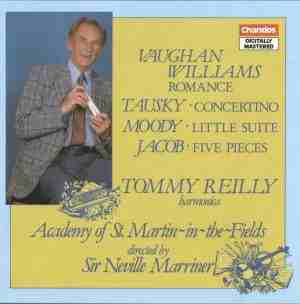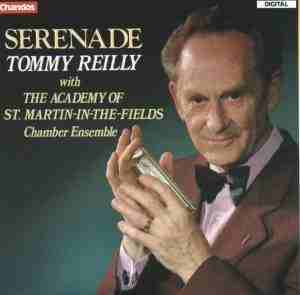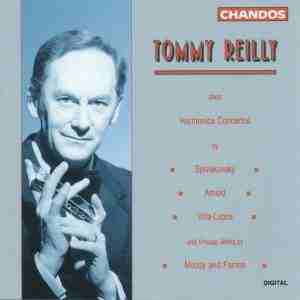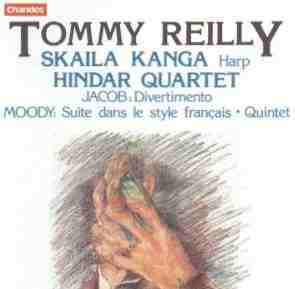 Tommy Reilly, harmonica
Tommy Reilly, harmonicaAcademy of St. Martin-in-the-Fields
Sir Neville Marriner, conductor
 Tommy Reilly, harmonica
Tommy Reilly, harmonica
Academy of St. Martin-in-the-Fields
Sir Neville Marriner, conductor
Program:
Ralph Vaughan Williams: Romance
Vilem Tausky: Concertino
Allegro moderato
Nocturne
Scherzo
James Moody: Little Suite
Bagatelle
Scherzino
Cantilena
Badinerie
Gordon Jacob: Five Pieces
Caprice
Cradle Song
Country Dance
Threnody
Russian Dance
total time: 46:39
CD released in 1988
LP released in 1977
review date: December 2000
Label: Chandos Records http://www.chandos-records.com/
 Tommy Reilly, harmonica
Tommy Reilly, harmonicaProgram:
James Moody: Bulgarian Wedding Dance
Faure: Pavane
Faure: Romance
Grieg: Norwegian Dance
George Martin: Adagietto
David Reilly: Aviator
Tommy Reilly: Serenade
Handel: Sonata
Allegro
Siciliana
Allegro
Faure: Au Bord de L'eau
Debussy: Bruyeres
Mendelssohn: On Wings of Love
Irish Traditional: My Lagen Love
Lennon & McCartney: Eleanor Rigby and Michelle
total time: 49:18
Released in 1986
Label: Chandos Records http://www.chandos-records.com/
 Tommy Reilly, harmonica
Tommy Reilly, harmonica
Munchner Rundfunkorchester
Rundfunkorchester des Sudwestfunks
Basel Radio Symphony Orchestra
Program:
Michael Spivakovsky: Concerto for Harmonica & Orchestra
Fuocoso - Dance Drole
Romance, Andante, dolce
Scherzo, Allegro ma non troppo
Malcolm Arnold: Concerto for Harmonica & Orchestra
Grazioso
Mesto
Con brio
Heitor Villa-Lobos: Concerto for Harmonica & Orchestra
Allegro moderato
Andante
Allegro
James Moody: Toledo, Spanish Fantasy for Harmonica & Orchestra
Robert Farnon: Prelude and Dance for Harmonica & Orchestra
total time: 60:24
CD released in 1993
review date: December 2000
Label: Chandos Records http://www.chandos-records.com/
Program:
Gordon Jacob: Divertimento for Harmonica and String Quartet
James Moody: Suite dans le style francais
James Moody: Quintet for Harmonica and String Quartet
total time: 57:44
Label: Chandos Records http://www.chandos-records.com/
Review by Henry Doktorski:
Curiously enough, Reilly did not begin his musical training on the mouth organ; his instrument was violin, which he began studying at the age of eight. He became good enough to study at the Leipzig Conservatory, but was summarily arrested by the Gestapo and was held for five years as a prisoner-of-war in Nazi Germany.
At the risk of digressing, let me relate a story about fate. Many centuries ago, a Chinese peasant's only horse escaped and ran away into the wild. The peasant's son exclaimed to the father, "Bad luck," to which the father philosophically replied, "Good luck, bad luck; who knows?"
The next day the horse returned into the corral on its own bringing with it a half-dozen mares which it had adopted in the wild. The son exclaimed, "Good luck," to which the father replied, "Good luck, bad luck; who knows?"
The next day, while attempting to train one of the new horses, the son was violently thrown off and broke his leg badly. He exclaimed, "Bad luck." Naturally the father quietly responded, "Good luck, bad luck; who knows?"
The next day the Chinese emperor declared war on Mongolia and drafted all the young men into the army. The son exclaimed, "Good luck; my injury will insure that I do not die in war!" and the father replied as we expect, "Good luck, bad luck; who knows?"
Certainly we consider Reilly's misfortune to spend so many years in a prison camp to be ill fortune. However, true to his determined character, he was able to utilize that difficult time to develop and perfect his musical skills on the harmonica, an instrument which he was permitted to play while imprisoned. I suspect that without this austerity, Reilly may have become a violin virtuoso instead. After the war, he began in earnest making a career from playing the harmonica.
On these four discs is a veritable treasure of classical harmonica pieces; most are original works composed for the instrument, but a few are transcriptions. (Reilly has also recorded albums of popular and folk music.) Reilly's corroboration with Sir Neville Marriner and the Academy of St. Martin-in-the-Fields -- disc number one in our reviewing order -- was especially rewarding to me. This disc features works by Vaughan Williams, Vilem Tausky, James Moody and Gordon Jacob. Regarding the incredibly difficult cadenza in the first movement of the Tausky concerto, Reilly said, "Every note was penned by Vilem, with the exception of one short passage which I had to alter in order to stay alive!"
The second CD, Serenade, is titled after Reilly's own 2 minute composition for solo harmonica which he wrote as a test piece for the World Harmonica Championship. Although the piece is not a flashy tour-de-force, it nonetheless demands much from the performer both in technique (double stops pervade the entire serenade) and interpretation. This disc includes some movements from Handel's sonatas for flute and keyboard -- arranged for harmonica and string ensemble by James Moody - which are playable on the harmonica, as some trills are impossible to execute on harmonica.
This CD could have been titled "From Baroque to the Beatles." Included are two Lennon and McCartney songs arranged by George Martin and one piece composed by George Martin. Reilly and Martin were associates for many years; some of the first recordings George Martin produced at EMI were made with Tommy Reilly, several years before Martin became famous as the record producer for the Fab Four. Martin's Adagietto is a gentle work which moves along at an unhurried pace. The paired medley, Eleanor Rigby and Michelle, are perfect for harmonica and strings; the former was originally recorded with strings by the Beatles and the latter, I imagine, has been performed by hundreds of string orchestra from the Hollywood Strings to Mantovanni.
The third disc features the historic Michael Spivakovsky harmonica concerto - the first important full-scale concerto for the instrument, and also works by Villa-Lobos, Malcolm Arnold, James Moody and Robert Farnon. Reilly said, "The big change in my playing came when Michael Spivakovsky wrote a concerto for me in 1951. The months I spent with him taught me a lot. Until then I never realized how much could be produced from the harmonica. Although Spivakovsky did not play harmonica, he instinctively knew what could be done on the instrument and he made me do it! He was a hard taskmaster, but I shall always be grateful to him for bullying me!"
The fourth and final disc features chamber works by Gordon Jacob and James Moody. The latter had a long association with Reilly; Moody was Reilly's piano accompanist for more than thirty years. (They recorded a popular CD together: Thanks for the Memory.) Moody decided to learn to play the harmonica himself so he could better compose and arrange for the instrument. The Classical Free-Reed, Inc. published a review of another CD of James Moody's compositions (see James Hughes Plays James Moody.)
In conclusion, let me share a story told by Sigmund Groven from the CD booklet notes of this fourth CD.
I heartily recommend these CDs for all classical harmonica lovers. Buy them before they go out of print. You won't be disappointed.
CD No. 4: Tommy Reilly
Works for Harmonica, Harp, and String Quartet Tommy Reilly, harmonica
Tommy Reilly, harmonica
Skaila Kanga, harp
Kindar Quartet
March
Romance
Siciliano
Scherzetto
Sarabande
Slavonic Dance
Elegy
Jig
Allegro moderato
Andante moderato - Allegro ma con espressione
Lento - Andante moderato
Allegro vivace
Allegretto con espressione
Allegro moderato
Lento
Moderato, con variazioni
CD released in 1990
review date: December 2000 When Tommy Reilly first appeared as soloist with the Bergen Philharmonic in Norway (one of the world's oldest symphony orchestras) in 1963, the famous American actor Earle Hyman was at the same time appearing as Othello at Den Nationale Scene in Grieg's hometown, and an elderly lady, in a state of shock, was heard to exclaim: "This must be the end of the world: a mouth-organ playing with our famous philharmonic and a Negro in our National Theatre!"
About The Free-Reed Review Invitation to Contributors / Submission
Guidelines
Back to The Free-Reed Review Contents
Page
Back
to The Classical Free-Reed, Inc. Home Page